Module 3
1. Module 3
1.27. Page 5
Module 3—Electrical Phenomena
Electric Field Lines in Nature
St. Elmo’s fire is not the only natural phenomenon that is explained using electric field lines. Sharks are capable of detecting the weak electric fields that other animals produce through their muscle activity. This ability enables sharks to detect prey that has buried itself under shallow sand on the seabed.
Just as a source mass surrounds itself with gravitational field lines, a source charge surrounds itself with electric field lines. Since muscle activity is triggered by the moving charges in nerve cells, muscle contractions produce electric fields. In this case, the source charges are very weak, so the resulting electric fields are also very weak.
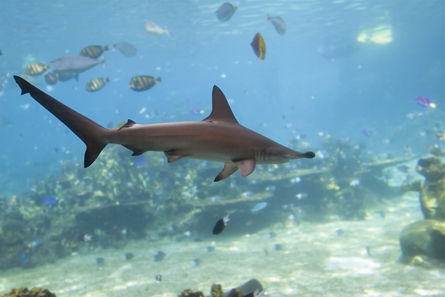
© Ian Scott/shutterstock
Hammerhead sharks have sensors located in their snouts that allow this predator to detect very weak electrical fields. The hammerhead shark swims close to the seabed seeking prey that has hidden itself under the sand. The electric field lines produced by the prey can extend up into the water above the sand. As the shark swims past a location where the density of the electric field lines suddenly change, the sensors in the shark’s snout are triggered. The shark uses this information to pinpoint the exact location of its hidden prey.
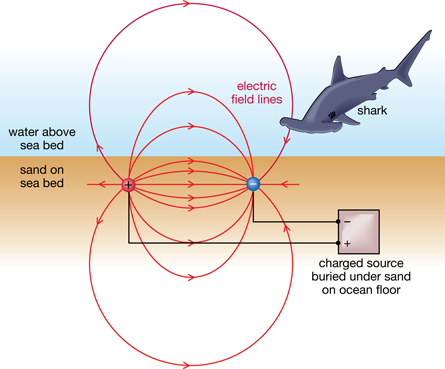
Scientists have verified this ability of sharks by burying pairs of oppositely charged sources in the sand. As the shark swims closer to the sources, the special sensors in its snout detect a change in the density of electric field lines. Where the field lines are most concentrated, the shark disturbs the sand looking for a meal. Astonishingly, this type of behaviour was observed with electric fields as weak as 5 × 10–7 N/C.
 Read
Read
You can learn more about electric field lines and the patterns they form by reading page 554 of your textbook.
 Self-Check
Self-Check
SC 12.
- Are the field lines in the illustration with the shark drawn in a way that is consistent with the rules for drawing electric field lines listed on page 554 of your textbook?
- Use the rules listed on page 554 of your textbook to identify the location in the illustration where the magnitude of the electric field would be greatest.
- Use your answer to SC 12.b. to identify the location that would likely draw the shark.
 Self-Check Answers
Self-Check Answers
SC 12.
- Yes, the field lines are drawn in a way that is consistent with the rules stated in the textbook. Electric field lines start from the positive source and extend radially. Electric field lines terminate at the negative source. The electric field lines are tightly packed between the two sources, indicating that this is where the magnitude of the electric field is greatest.
- The magnitude of the electric field would be greatest where the field lines are densely packed together. This occurs in the region between the two sources but closer to one source or the other.
- Given that the sensors in the shark’s snout are designed to detect changes in the density of electric field lines, these sensors would tend to direct the shark to move into the space between the two charged sources but closer to one source or the other.
 Read
Read
Read the instructions in “Minds On: Drawing Electric Field Lines” on page 555 of your textbook.
 Self-Check
Self-Check
SC 13. On a sheet of paper, sketch the patterns of the electric field lines shown in each of the situations illustrated in the “Minds On: Drawing Electric Field Lines” activity. Complete each illustration by adding arrowheads to each of the electric field lines.
 Self-Check Answers
Self-Check Answers
SC 13.
a. 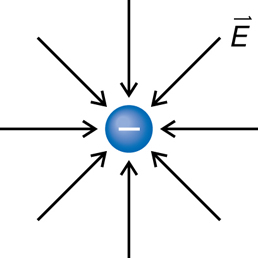
b. 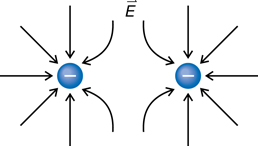
c. 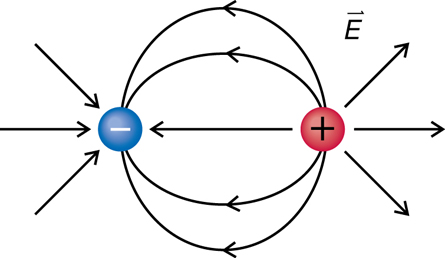
d. 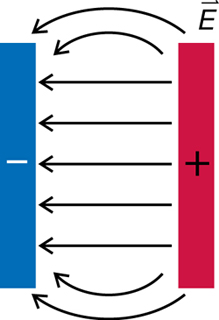
e. 
Electric Fields on the Surfaces of Conductors

© Stephen Strathdee/shutterstock
Recall that St. Elmo’s fire has been observed on the wing tips of aircraft that are flying near large concentrations of charge within a thunderstorm. The reason this phenomenon occurs on wing tips, as it does at the ends of other sharply pointed projections, has to do with the distribution of charge on the surface of the aircraft.
As an aircraft flies through thunderclouds, the metal surface of the aircraft can become charged. If electrons are transferred to the aircraft, these excess negative charges will move as far apart as possible due to like charges repelling one another. On a flat metallic surface, the negative charges spread out evenly. So, the resulting pattern of electric field due to these charges is also evenly distributed.
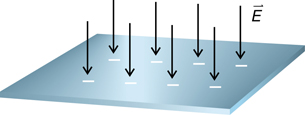
If the same surface is slightly bent, more charges can be added. Can you think why this would be the case? The reason has to do with the fact that charges on opposite sides of the curved surface are unable to repel one another as effectively as they can when the surface is completely flat. On curved surfaces, the electrostatic force that repels each charge away from the others has a component that is no longer parallel to the surface. This means that the parallel component of the force is less and therefore there is less force acting to separate each individual charge away from the others. The result is that the charges can be packed closer together. It follows that the density of the field lines also increases.
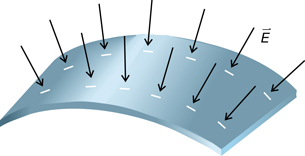
To pack more charges on the surface, and get an even denser pattern of field lines, the same surface could be bent into a more pronounced curve. As the curvature of a given surface increases, so does the capacity of the surface to concentrate charge and produce regions of intense electric fields.
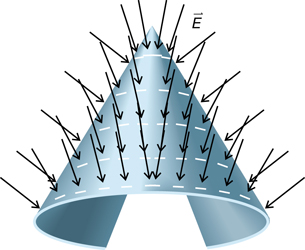
 Read
Read
You can learn more about the role of the electrostatic force in explaining the patterns illustrated in the previous diagrams by reading pages 555 to 558 of your textbook. Note the explanation of the electric field inside a hollow conductor as well as the electric field between two charged parallel plates.
 Self-Check
Self-Check
SC 14. Record the following diagrams in your notebook. Complete each diagram by sketching the electric field lines within each object.

SC 15. Refer to the “infoBIT” in the margin on page 558 of your textbook. Explain the role of the flexible metal shielding in the cable that is used to bring TV signals into a home.
SC 16. Electric fields are a key component of radio waves. Other than convertibles, most vehicles on the roadway can be thought of as metal boxes with holes cut in them for windows. Use this information to explain why the antenna for a vehicle’s radio must be mounted outside of the vehicle or built into the windshield.
 Self-Check Answers
Self-Check Answers
SC 14.
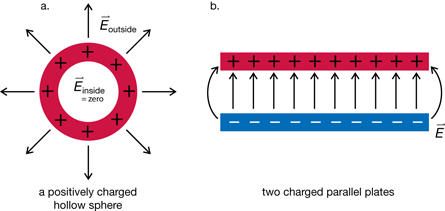
SC 15. The metal shielding prevents electrical and magnetic interference from influencing the TV signals that are transmitted through the cable. The flexible metal shielding effectively surrounds the conductor, encasing the TV signal with a hollow metal covering. Since electric fields within a hollow conductor are zero, there is no unwanted influence on the TV signals transmitted through the cable.
SC 16. If electric fields are a key component of radio waves, then radio waves cannot penetrate the interior space of a vehicle because electric fields inside a hollow conductor are zero. By placing the antenna outside the vehicle or in the windshield, the radio waves do not have to penetrate the metal shell of the vehicle to be detected.